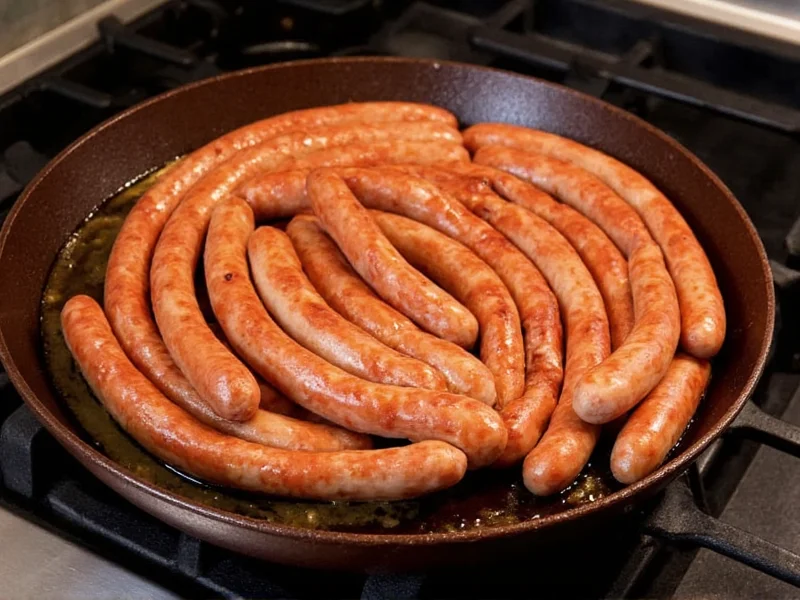Bratwurst, Germany's beloved pork sausage, deserves careful preparation to honor its culinary heritage. When cooked properly, brats deliver juicy interiors with a satisfying snap from the natural casing. Many home cooks make the mistake of throwing raw brats directly on a hot grill, resulting in split casings and dry meat. Understanding the proper technique transforms this simple sausage into a restaurant-quality meal.
Why the Two-Step Cooking Method Works Best
The ideal bratwurst cooking process combines gentle poaching with careful browning. This approach serves three critical purposes:
- Ensures food safety by reaching the required 160°F internal temperature without burning the exterior
- Preserves the sausage's natural juices by preventing casing rupture
- Develops complex flavors through controlled Maillard reaction during the browning phase
Step-by-Step Guide to Perfect Bratwurst
1. The Pre-Cooking Stage
Begin by preparing a flavorful poaching liquid. In a large skillet or pot, combine:
- 1 bottle (12 oz) of lager-style beer (avoid hoppy IPAs)
- 1 sliced onion
- 1 tablespoon whole mustard seeds
- 2-3 whole cloves of garlic
- Salt and pepper to taste
Bring the mixture to a gentle simmer (not a rolling boil), then add the brats. Cook for 10-12 minutes until they reach 140°F internally. This gentle cooking method sets the proteins without causing the casings to burst.
2. The Finishing Stage
After pre-cooking, transfer the brats to your cooking surface:
| Cooking Method | Temperature | Time | Pro Tips |
|---|---|---|---|
| Grill | Medium (350-375°F) | 8-10 minutes | Rotate frequently; use indirect heat if flare-ups occur |
| Sauté Pan | Medium | 6-8 minutes | Add reserved poaching onions for extra flavor |
| Oven | 400°F | 12-15 minutes | Place on wire rack over baking sheet for even browning |
How to Tell When Bratwurst Is Perfectly Cooked
Visual cues alone can't guarantee proper doneness. Use these reliable indicators:
- Internal temperature: 160°F (71°C) measured with an instant-read thermometer at the thickest part
- Texture: Firm but yielding when gently pressed, with a slight bounce-back
- Color: Deep golden brown with caramelized spots, not blackened
- Juices: Clear, not pink, when pierced (though piercing isn't recommended)
Never rely solely on color or cooking time, as sausage thickness and cooking equipment vary significantly. An inexpensive meat thermometer eliminates guesswork and ensures food safety.
Avoid These Common Bratwurst Cooking Mistakes
Even experienced cooks make these errors when preparing bratwurst:
- High-heat direct cooking: Causes casing rupture and flare-ups. Always start with medium heat.
- Piercing the casing: Releases precious juices. If fat bubbles form, reduce heat instead of puncturing.
- Skipping the pre-cook step: Leads to uneven cooking and potential food safety issues.
- Overcrowding the cooking surface: Creates steam that prevents proper browning.
- Using the wrong beer: Strong, hoppy beers can make brats bitter. Opt for mild lagers or pilsners.
Traditional Serving Suggestions
In Germany, bratwurst appears in butcher shops and beer gardens with simple, complementary sides:
- Bread: Crusty pretzel rolls or rye bread
- Condiments: Sweet German mustard, sauerkraut, or stone-ground mustard
- Sides: Potato salad, red cabbage, or grilled onions
- Drinks: German lager, wheat beer, or non-alcoholic sparkling apple cider
For an authentic experience, serve brats immediately after cooking while the casing remains crisp and the interior stays juicy.
Storage and Reheating Tips
Properly stored cooked brats maintain quality for 3-4 days in the refrigerator:
- Store in an airtight container with some of the cooking liquid to retain moisture
- Reheat gently in a skillet with a splash of beer or broth over medium-low heat
- Avoid microwave reheating, which makes casings rubbery
- Never refreeze previously frozen brats after cooking
Frequently Asked Questions
Can you cook bratwurst without boiling first?
Yes, but with caution. You can cook bratwurst directly on the grill or in a skillet, but you must use lower heat (300-325°F) and cook much slower—about 20-25 minutes. This method requires careful attention to prevent casing rupture. The pre-boiling method remains preferable for consistent results, especially for beginners.
How do you prevent bratwurst from splitting while cooking?
To prevent splitting, never prick brats with a fork. Instead, use the two-step cooking method: gently poach in beer or broth first, then finish over medium heat. Keep cooking temperatures moderate—high heat causes rapid expansion of internal fats and juices, leading to burst casings. If bubbles form on the surface, reduce the heat immediately.
What's the difference between grilling and pan-frying bratwurst?
Grilling creates distinctive char marks and imparts smoky flavor, while pan-frying offers more controlled, even browning. Grilling requires careful attention to prevent flare-ups from dripping fat, whereas pan-frying allows you to incorporate the cooking juices into a sauce. Both methods work well after pre-cooking, but grilling provides that authentic outdoor flavor many associate with traditional bratwurst preparation.
Can you cook frozen bratwurst without thawing?
Yes, but with adjustments. Add 5-7 minutes to the poaching time when cooking frozen brats, ensuring they reach 160°F internally. Never cook frozen brats directly over high heat, as this guarantees a burnt exterior with a raw interior. The gentle poaching method works best for frozen sausages, allowing even heating throughout.
What beer works best for cooking bratwurst?
Choose mild lagers, pilsners, or German-style wheat beers. Avoid hoppy IPAs or strong stouts, which can make the brats bitter. Traditional German beers like Bitburger, Warsteiner, or Paulaner work perfectly. Non-alcoholic options include ginger ale or apple juice mixed with broth for similar sweet-tangy flavor profiles.











 浙公网安备
33010002000092号
浙公网安备
33010002000092号 浙B2-20120091-4
浙B2-20120091-4